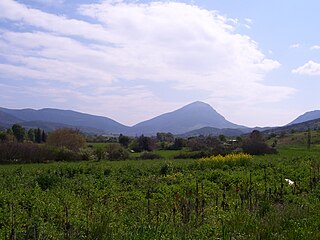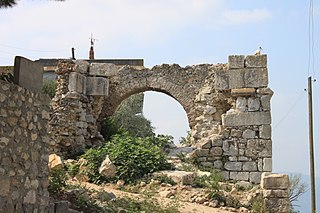
Apollonia was an ancient Greek city located on the right bank of the Aous river. Its ruins are situated in the Fier County, next to the village of Pojani (Polina), in modern-day Albania. Apollonia was founded in 588 BCE by Greek colonists from Corfu and Corinth, on a site where native Illyrian tribes lived, and was perhaps the most important of the several classical towns known as Apollonia. Apollonia flourished in the Roman period and was home to a renowned school of philosophy, but began to decline in the 3rd century AD when its harbor started silting up as a result of an earthquake. It was abandoned by the end of Late Antiquity.

Troezen is a small town and a former municipality in the northeastern Peloponnese, Greece, on the Argolid Peninsula. Since the 2011 local government reform it is part of the municipality Troizinia-Methana, of which it is a municipal unit. It is part of the Islands regional unit.
Sozopolis in Pisidia, which had been called Apollonia (Ἀπολλωνία) and Apollonias (Ἀπολλωνίας) during Seleucid times, was a town in the former Roman province of Pisidia, and is not to be confused with the Thracian Sozopolis in Haemimonto in present-day Bulgaria.

Tripolis on the Meander – also Neapolis, Apollonia, and Antoniopolis – was an ancient city on the borders of Phrygia, Caria and Lydia, on the northern bank of the upper course of the Maeander, and on the road leading from Sardes by Philadelphia to Laodicea ad Lycum. It was situated 20 km to the northwest of Hierapolis.
Apollonia was an ancient city of Sicily, which, according to Stephanus of Byzantium, was situated in the neighborhood of Aluntium and Calacte. Cicero also mentions it and in conjunction with Haluntium, Capitium, and Enguium, in a manner that seems to imply that it was situated in the same part of Sicily with these cities; and we learn from Diodorus that it was at one time subject to Leptines, the tyrant of Enguium, from whose hands it was wrested by Timoleon, and restored to an independent condition. A little later we find it again mentioned among the cities reduced by Agathocles, after his return from Africa, 307 BCE. But it evidently regained its liberty after the fall of the tyrant, and in the days of Cicero was still a municipal town of some importance. From this time it disappears from history, and the name is not found either in Pliny or Ptolemy.
Apollonia was a city of ancient Crete, near Knossos, the inhabitants of which were most treacherously treated by the Cydoniatae, who were their friends and allies. The editors of the Barrington Atlas of the Greek and Roman World place Apollonia at Gazi.
Apollonia, also called Eleuthera (Ἐλεύθερα) was an ancient city of Crete, on the south coast. William Smith states that the philosopher Diogenes Apolloniates was a native of the environs of Apollonia, although other scholars claim that the Apollonia in question was the Thracian one. The editors of the Barrington Atlas of the Greek and Roman World place Apollonia at Sellia.
Apollonia was the ancient chief town of Chalcidice in Macedonia, situated north of Olynthus, and a little south of the Chalcidian mountains. That this Apollonia is a different place from Apollonia in Mygdonia, appears from Xenophon, who describes the Chalcidian Apollonia as distant 10 to 12 miles from Olynthus. It was probably this Apollonia that struck the beautiful Chalcidian coins, bearing on the obverse the head of Apollo, and on the reverse his lyre, with the legend Χαλκιδέων. Demosthenes claims that Apollonia was among the Greek cities destroyed by Philip II of Macedon, probably during his war against the Chalcidian League in 348 BCE when he also destroyed Olynthus.
Apollonia was an ancient town in the peninsula of Acte, or Mount Athos in Macedonia, the inhabitants of which were called Macrobii. Homer mentions Athos in the Iliad and, in connection to Mount Athos, Gaius Plinius Secundus, refers to the cities of Ouranoupolis, Palaiotrion, Thysson, Kleonas, and Apollonia.
Apollonia was a town of ancient Mysia, Anatolia, situated on an eminence east of Pergamum, on the way to Sardis. It seems to have been near the borders of Mysia and Lydia.

Apollonia or Apollonia-on-the-Rhyndacus was an ancient town near the Rhyndacus river in northwestern Anatolia. Strabo placed it in Mysia, causing some to misidentify the site as Uluabat on the western shore of Lake Uluabat. However, the site is actually the promontory tombolo on the northeastern shore, near modern Gölyazı. The remains of Apollonia are inconsiderable. The Rhyndacus flows into the lake and issues from it a deep and muddy river. The lake extends from east to west and is studded with several islands in the northeast part, on one of which is Gölyazı, but the dimensions vary greatly through the seasons.

Apollonia was a town of Mygdonia in Macedon, south of Lake Bolbe, and north of the Chalcidian mountains, on the road from Thessalonica to Amphipolis, as we learn from the Acts of the Apostles, and the Itineraries. Pliny the Elder mentions this Apollonia.
In Greek mythology, Olynthus was a son of Heracles and Bolbe, from whom the ancient city of Olynthus, and the river Olynthus near Apollonia, were believed to have received their name according to Athenaeus. According to Conon and Stephanus of Byzantium Olynthus was son of king Strymon. When he had been killed during the chase by a lion, his brother Brangas buried him on the spot where he had fallen, and called the town which he subsequently built there Olynthus.
Cestria or Kestria, also known as Ilium or Ilion (Ἴλιον), or Troja (Τροΐα), was a town in ancient Epirus. Its district was called Cestrine or Kestrine (Κεστρίνη), and was in the south of Chaonia, separated from Thesprotia by the river Thyamis. It is said to have received its name from Cestrinus, son of Helenus and Andromache, having been previously called Cammania or Kammania (Καμμανία). The principal town of the district was Cestria, but its more usual name appears to have been Ilium or Troja, in memory of the Trojan colony of Helenus. In the neighbourhood are those fertile pastures, which were celebrated in ancient times for the Cestrinic oxen. The inhabitants of the district were called Κεστρηνοί by the poet Rhianus.
Apollonia was an ancient town on one of the islands of the Echinades in ancient Acarnania.
Apollonia was an ancient town on the island of Siphnos.
Apollonis , also known as Apollonia (Ἀπολλωνία), Apollones (Ἀπολλώνης), and Apollonias (Ἀπολλωνίας), was a city in ancient Lydia. It was located south of Apollonia in Mysia, where there is a ridge of hills, after crossing which the road to Sardis had on the left Thyatira, and on the right Apollonis, which was 300 stadia from Pergamum, and the same distance from Sardis. It was named after the queen Apollonis, the mother of Eumenes II and Attalus II of Pergamum, in the place of an older city; possibly Doidye. It was mentioned by Cicero. It was destroyed in 17 CE by the great earthquake that destroyed twelve cities of Asia Minor. Tiberius rebuilt the city. It issued coins; those from Marcus Aurelius to Severus Alexander are extant. Apollonis is a titular see of the Roman Catholic Church.
Apollonia Salbaces or Apollonia Salbakes was a town in ancient Anatolia.







